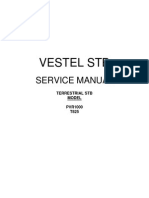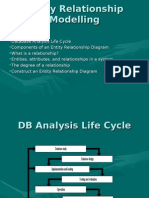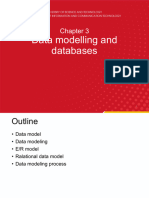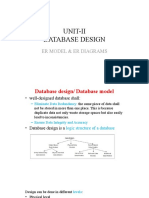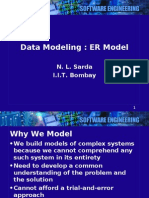Entity/Relationship Modelling: Database Systems Lecture 4 Natasha Alechina
Entity/Relationship Modelling: Database Systems Lecture 4 Natasha Alechina
Uploaded by
Ruman MahmoodCopyright:
Available Formats
Entity/Relationship Modelling: Database Systems Lecture 4 Natasha Alechina
Entity/Relationship Modelling: Database Systems Lecture 4 Natasha Alechina
Uploaded by
Ruman MahmoodOriginal Title
Copyright
Available Formats
Share this document
Did you find this document useful?
Is this content inappropriate?
Copyright:
Available Formats
Entity/Relationship Modelling: Database Systems Lecture 4 Natasha Alechina
Entity/Relationship Modelling: Database Systems Lecture 4 Natasha Alechina
Uploaded by
Ruman MahmoodCopyright:
Available Formats
Entity/Relationship Modelling
Database Systems Lecture 4
Natasha Alechina
In This Lecture
• Entity/Relationship models
• Entities and Attributes
• Relationships
• Attributes
• E/R Diagrams
• For more information
• Connolly and Begg chapter 11
• Ullman and Widom chapter 2
Entity Relationship Modelling
Database Design
• Before we look at • Conceptual design
how to create and • Build a model
use a database we’ll independent of the
look at how to choice of DBMS
design one • Logical design
• Need to consider • Create the database
in a given DBMS
• What tables, keys,
and constraints are • Physical design
needed? • How the database is
• What is the database stored in hardware
going to be used for?
Entity Relationship Modelling
Entity/Relationship Modelling
• E/R Modelling is used • Example
for conceptual design • In a University
• Entities - objects or database we might
have entities for
items of interest
Students, Modules and
• Attributes - facts Lecturers. Students
about, or properties might have attributes
of, an entity such as their ID,
• Relationships - links Name, and Course, and
could have
between entities
relationships with
Modules (enrolment)
and Lecturers
(tutor/tutee)
Entity Relationship Modelling
Entity/Relationship Diagrams
• E/R Models are often Lecturer ID
represented as E/R Name Course
diagrams that
• Give a conceptual
view of the database Tutors Student
• Are independent of
the choice of DBMS
• Can identify some
problems in a design Module Studies
Entity Relationship Modelling
Entities
• Entities represent • Entities have
objects or things of • A general type or
interest class, such as
• Physical things like Lecturer or Module
students, lecturers, • Instances of that
employees, products particular type, such
• More abstract things as Steve Mills,
like modules, orders, Natasha Alechina are
courses, projects instances of Lecturer
• Attributes (such as
name, email address)
Entity Relationship Modelling
Diagramming Entities
• In an E/R Diagram, Lecturer ID
an entity is usually Name Course
drawn as a box with
rounded corners
Tutors Student
• The box is labelled
with the name of the
class of objects
represented by that Module Studies
entity
Entity Relationship Modelling
Attributes
• Attributes are facts, • Attributes have
aspects, properties, • A name
or details about an • An associated entity
entity • Domains of possible
• Students have IDs, values
names, courses, • Values from the
addresses, … domain for each
• Modules have codes, instance of the entity
titles, credit weights, they are belong to
levels, …
Entity Relationship Modelling
Diagramming Attributes
• In an E/R Diagram Lecturer ID
attributes may be Name Course
drawn as ovals
• Each attribute is
Tutors Student
linked to its entity by
a line
• The name of the
attribute is written in Module Studies
the oval
Entity Relationship Modelling
Relationships
• Relationships are an • Relationships have
association between • A name
two or more entities • A set of entities that
• Each Student takes participate in them
several Modules • A degree - the
• Each Module is taught number of entities
by a Lecturer that participate (most
• Each Employee works have degree 2)
for a single • A cardinality ratio
Department
Entity Relationship Modelling
Cardinality Ratios
• Each entity in a • One to one (1:1)
relationship can • Each lecturer has a
unique office
participate in zero,
• One to many (1:M)
one, or more than • A lecturer may tutor
one instances of that many students, but each
relationship student has just one
tutor
• This leads to 3 types • Many to many (M:M)
of relationship… • Each student takes
several modules, and
each module is taken by
several students
Entity Relationship Modelling
Diagramming Relationships
• Relationships are Lecturer ID
links between two Name Course
entities
• The name is given in
Tutors Student
a diamond box
• The ends of the link
show cardinality
Module Studies
One Many
Entity Relationship Modelling
Removing M:M Relationships
• Many to many Student
relationships are
difficult to represent Student
Has
• We can split a many
to many relationship
Studies Enrolment
into two one to many
relationships
In
• An entity represents Module
the M:M relationship
Module
Entity Relationship Modelling
Making E/R Models
• To make an E/R • General guidelines
model you need to • Since entities are
identify things or objects they
• Enitities are often nouns in the
description
• Attributes
• Attributes are facts or
• Relationships properties, and so are
• Cardinality ratios often nouns also
• from a description • Verbs often describe
relationships between
entities
Entity Relationship Modelling
Example
A university consists of a number of
departments. Each department offers several
courses. A number of modules make up each
course. Students enrol in a particular course
and take modules towards the completion of
that course. Each module is taught by a
lecturer from the appropriate department, and
each lecturer tutors a group of students
Entity Relationship Modelling
Example - Entities
A university consists of a number of
departments. Each department offers several
courses. A number of modules make up
each course. Students enrol in a particular
course and take modules towards the
completion of that course. Each module is
taught by a lecturer from the appropriate
department, and each lecturer tutors a group
of students
Entity Relationship Modelling
Example - Relationships
• A university consists of a number of
departments. Each department offers several
courses. A number of modules make up each
course. Students enrol in a particular course
and take modules towards the completion of
that course. Each module is taught by a
lecturer from the appropriate department,
and each lecturer tutors a group of students
Entity Relationship Modelling
Example - E/R Diagram
Entities: Department, Course, Module, Lecturer, Student
Department
Course Module Lecturer
Student
Entity Relationship Modelling
Example - E/R Diagram
Each department offers several courses
Offers Department
Course Module Lecturer
Student
Entity Relationship Modelling
Example - E/R Diagram
A number of modules make up each courses
Offers Department
Course Includes Module Lecturer
Student
Entity Relationship Modelling
Example - E/R Diagram
Students enrol in a particular course
Offers Department
Course Includes Module Lecturer
Enrols In Student
Entity Relationship Modelling
Example - E/R Diagram
Students … take modules
Offers Department
Course Includes Module Lecturer
Takes
Enrols In Student
Entity Relationship Modelling
Example - E/R Diagram
Each module is taught by a lecturer
Offers Department
Course Includes Module Teaches Lecturer
Takes
Enrols In Student
Entity Relationship Modelling
Example - E/R Diagram
a lecturer from the appropriate department
Offers Department Employs
Course Includes Module Teaches Lecturer
Takes
Enrols In Student
Entity Relationship Modelling
Example - E/R Diagram
each lecturer tutors a group of students
Offers Department Employs
Course Includes Module Teaches Lecturer
Takes
Enrols In Student Tutors
Entity Relationship Modelling
Example - E/R Diagram
Offers Department Employs
Course Includes Module Teaches Lecturer
Takes
Enrols In Student Tutors
Entity Relationship Modelling
Entities and Attributes
• Sometimes it is hard • General guidelines
to tell if something • Entities can have
should be an entity attributes but
or an attribute attributes have no
smaller parts
• They both represent
objects or facts about • Entities can have
the world relationships between
them, but an attribute
• They are both often belongs to a single
represented by nouns entity
in descriptions
Entity Relationship Modelling
Example
We want to represent information about
products in a database. Each product
has a description, a price and a
supplier. Suppliers have addresses,
phone numbers, and names. Each
address is made up of a street address,
a city, and a postcode.
Entity Relationship Modelling
Example - Entities/Attributes
• Entities or attributes: • Products, suppliers,
• product and addresses all
• description
have smaller parts
• price
• supplier so we can make
• address them entities
• phone number • The others have no
• name
• street address
smaller parts and
• city belong to a single
• postcode entity
Entity Relationship Modelling
Example - E/R Diagram
Price
Description Product
Street address
Name Supplier Address City
Phone number Postcode
Entity Relationship Modelling
Example - Relationships
• Each product has a • Each supplier has an
supplier address
• Each product has a • A supplier has a
single supplier but single address
there is nothing to • It does not seem
stop a supplier sensible for two
supplying many different suppliers to
products have the same
• A many to one address
relationship • A one to one
relationship
Entity Relationship Modelling
Example - E/R Diagram
Price
Description Product
Has A Street address
Name Supplier Has A Address City
Phone number Postcode
Entity Relationship Modelling
One to One Relationships
• Some relationships • Example - the
between entities, A supplier-address
and B, might be relationship
redundant if • Is one to one
• It is a 1:1 relationship • Every supplier has an
between A and B address
• Every A is related to a • We don’t need
B and every B is addresses that are
related to an A not related to a
supplier
Entity Relationship Modelling
Redundant Relationships
• We can merge the a x
two entities that take
b A B y
part in a redundant
relationship together
c z
• They become a single
entity
• The new entity has all a x
the attributes of the
old one b AB y
c z
Entity Relationship Modelling
Example - E/R Diagram
Price
Description Product
Has A
Name Supplier City
Phone number Postcode Street address
Entity Relationship Modelling
Making E/R Diagrams
• From a description of • Draw the E/R
the requirements diagram and then
identify the • Look at one to one
• Entities relationships as they
• Attributes might be redundant
• Relationships • Look at many to
many relationships as
• Cardinality ratios of they might need to be
the relationships split into two one to
many links
Entity Relationship Modelling
Debugging Designs
• With a bit of practice
Student
E/R diagrams can be
used to plan queries How can you
Has
• You can look at the
find a list of
diagram and figure
out how to find useful students who
Enrolment
information are enrolled
• If you can’t find the in Database
information you need, In systems?
you may need to
change the design
Module
Entity Relationship Modelling
Debugging Designs
ID (3) For each instance of Enrolment in the
Student
Name
result of (2) find the corresponding Student
Has
ID
(2) Find instances of the Enrolment entity
Enrolment
Code with the same Code as the result of (1)
In
Code
(1) Find the instance of the Module
Module
Title entity with title ‘Database Systems’
Entity Relationship Modelling
You might also like
- Prepare and Present Gateaux, Tortes and Cakes, Display Petit Fours and Present DessertsDocument148 pagesPrepare and Present Gateaux, Tortes and Cakes, Display Petit Fours and Present DessertsBong Lacaden100% (16)
- SmartUP Manuale Installazione - GB - Rev5. 111120Document11 pagesSmartUP Manuale Installazione - GB - Rev5. 111120Emilio CortesNo ratings yet
- Case StudyDocument5 pagesCase StudyRuman Mahmood100% (1)
- ChillerDocument3 pagesChillerRomie CubalNo ratings yet
- Vestel STB: Service ManualDocument67 pagesVestel STB: Service ManualnaughtybigboyNo ratings yet
- Why Did Kodak Miss The Digital RevolutionDocument10 pagesWhy Did Kodak Miss The Digital Revolutionsharmas09No ratings yet
- Entity/Relationship Modelling: Database SystemsDocument41 pagesEntity/Relationship Modelling: Database SystemsbogirajaNo ratings yet
- Entity/Relationship ModellingDocument39 pagesEntity/Relationship ModellingBawa CoderNo ratings yet
- Er ClassDocument41 pagesEr ClassAsim jawedNo ratings yet
- Entity/Relationship Modelling: Database Systems Lecture # 5 Mr. Jahanzaib NiaziDocument45 pagesEntity/Relationship Modelling: Database Systems Lecture # 5 Mr. Jahanzaib NiaziIrfan Muddassir0% (1)
- Entity/Relationship ModellingDocument38 pagesEntity/Relationship ModellingHafiz Al Asad ManikNo ratings yet
- Entity-Relationship Diagram (ERD) : Yves WauteletDocument35 pagesEntity-Relationship Diagram (ERD) : Yves WauteletRihabNo ratings yet
- A724912995 - 23614 - 12 - 2018 - Lecture 4Document48 pagesA724912995 - 23614 - 12 - 2018 - Lecture 4Alok TiwariNo ratings yet
- 05 ChapterDocument40 pages05 ChapterZarnab sarfrazNo ratings yet
- 3 ERMtoRMDocument31 pages3 ERMtoRMbhupendramandal34No ratings yet
- Unit 1 Data Modeling - UpdatedDocument51 pagesUnit 1 Data Modeling - Updatedsahish pandavNo ratings yet
- Unit 1.2 Data ModelingDocument51 pagesUnit 1.2 Data Modelingranaji181223No ratings yet
- 04 Entity Relationship ModelDocument34 pages04 Entity Relationship ModelRoK CloneNo ratings yet
- Lecture Note 2 - Entity Relationship DiagramDocument31 pagesLecture Note 2 - Entity Relationship DiagramAndroid TVNo ratings yet
- Chapter 5: Entity-Relationship ModelDocument69 pagesChapter 5: Entity-Relationship ModelHưng PhạmNo ratings yet
- ITT 05219-ER ModelDocument34 pagesITT 05219-ER ModelSalum MasoudNo ratings yet
- Lecture1-ER Model-1Document38 pagesLecture1-ER Model-1. .No ratings yet
- Object Oriented ConceptsDocument30 pagesObject Oriented ConceptsDave LoveNo ratings yet
- W13 - Lecture 25 - ER DiagramDocument19 pagesW13 - Lecture 25 - ER Diagramsp22-bcs-139No ratings yet
- Itp311 Entity Relationship Diagram (Erd)Document33 pagesItp311 Entity Relationship Diagram (Erd)bsahulgaNo ratings yet
- Lec3 - Relational Database Design ERDDocument33 pagesLec3 - Relational Database Design ERDSonu SachdevNo ratings yet
- Er 1Document38 pagesEr 1sefwan100% (3)
- 10.ER ModelDocument51 pages10.ER ModelAditya AnandNo ratings yet
- 3 DB ErDocument59 pages3 DB ErDickNo ratings yet
- Entity Relationship ModelingDocument28 pagesEntity Relationship Modelingchembri022No ratings yet
- 3.1 Data Modeling enDocument55 pages3.1 Data Modeling entopkek69123No ratings yet
- DBMSDocument327 pagesDBMSbharatkaushik9760No ratings yet
- CH 3Document37 pagesCH 3Ashenafi EliasNo ratings yet
- Unit-Ii Database Design: Er Model & Er DiagramsDocument81 pagesUnit-Ii Database Design: Er Model & Er DiagramsSneha IgnatiousNo ratings yet
- ER DiagramsDocument35 pagesER Diagramsvisheshg2027iNo ratings yet
- ER DiagramDocument70 pagesER DiagramReemmoq 12No ratings yet
- 04-Entity-Relational Model (Part 1) - SCDDocument46 pages04-Entity-Relational Model (Part 1) - SCDMuhammad Isa Al AnshoriNo ratings yet
- Dbms-Module - 2 Updated at 07-02-2023Document107 pagesDbms-Module - 2 Updated at 07-02-2023edrickwitch01No ratings yet
- Data Modeling ERDocument89 pagesData Modeling ERapi-2754702833% (3)
- ER Diagram in DBMSDocument3 pagesER Diagram in DBMSAlyssa C. BaguioNo ratings yet
- Data Models ERDocument58 pagesData Models ERMukul SharmaNo ratings yet
- Entity Relationship Diagram: Ruben A. Parazo Faculty, Department of Computer StudiesDocument30 pagesEntity Relationship Diagram: Ruben A. Parazo Faculty, Department of Computer StudiesPaula Rodalyn MateoNo ratings yet
- Lecture 5Document54 pagesLecture 5wxcfxbxmsgNo ratings yet
- DB Design Using ER ModelDocument90 pagesDB Design Using ER ModelPaylaşım KanalıNo ratings yet
- 8803578Document90 pages8803578Andrea DetomasNo ratings yet
- Chapter 6: Database Design Using The E-R ModelDocument90 pagesChapter 6: Database Design Using The E-R Modelsupriopaul461No ratings yet
- Unit-2 DBMSDocument43 pagesUnit-2 DBMSanisha.kumariNo ratings yet
- ER Diagram Models SE ExamplesDocument68 pagesER Diagram Models SE ExamplesKhushal KumarNo ratings yet
- Understanding The Basics:Object Oriented ConceptsDocument47 pagesUnderstanding The Basics:Object Oriented ConceptsAadam YuusufNo ratings yet
- 5.Entity Relationship ModelDocument21 pages5.Entity Relationship Modelpsanthosh6792No ratings yet
- Entity Relationship ModelDocument23 pagesEntity Relationship ModelPeach BlancNo ratings yet
- Lecture 5 - ER Diagram in DBMSDocument32 pagesLecture 5 - ER Diagram in DBMSNjemax PanasheNo ratings yet
- Chapter 4Document38 pagesChapter 4rjbxtech5911pbx1No ratings yet
- The EEE Model Lect 1Document16 pagesThe EEE Model Lect 1syed hamzaNo ratings yet
- Lecture 2 ERDDocument26 pagesLecture 2 ERDma4375936No ratings yet
- 8.Object-Oriented Modelling DesignDocument49 pages8.Object-Oriented Modelling DesignﱞﱞﱞﱞﱞﱞﱞﱞﱞﱞﱞﱞﱞﱞﱞﱞﱞﱞﱞﱞﱞﱞﱞﱞNo ratings yet
- Dbms Raman. 7april2021Document13 pagesDbms Raman. 7april2021Hardaras SinghNo ratings yet
- Relational Data Model - Lec2Document23 pagesRelational Data Model - Lec2Mahesh KeerthisinghaNo ratings yet
- CST06105 - Fundamentals of OOP Introductory Lecture Dr. Msury Mahunnah E-Mail: Msury - Mahunnah@ifm - Ac.tzDocument29 pagesCST06105 - Fundamentals of OOP Introductory Lecture Dr. Msury Mahunnah E-Mail: Msury - Mahunnah@ifm - Ac.tzsteward materuNo ratings yet
- Chapter 3Document44 pagesChapter 3Sura OGNo ratings yet
- Lecture 1 - Introduction To OOPDocument61 pagesLecture 1 - Introduction To OOPMOHAMED HASSANNo ratings yet
- Requiremen Ts AnalysisDocument42 pagesRequiremen Ts Analysisrajesh shekarNo ratings yet
- Lecture 2 - ModelsDocument45 pagesLecture 2 - Modelsjubairahmed1678No ratings yet
- E R DiagramDocument51 pagesE R Diagrammandeep.22scse1290042No ratings yet
- Unit 1Document335 pagesUnit 1reqmail2023No ratings yet
- Quiz 01 Q1Document3 pagesQuiz 01 Q1Ruman MahmoodNo ratings yet
- Residential Garbage Application Form: Applicant DetailsDocument2 pagesResidential Garbage Application Form: Applicant DetailsRuman MahmoodNo ratings yet
- Major World Religions Assignment 01: Purpose of ReligionDocument4 pagesMajor World Religions Assignment 01: Purpose of ReligionRuman MahmoodNo ratings yet
- Chapter 5 EquationsDocument7 pagesChapter 5 EquationsRuman MahmoodNo ratings yet
- Assignment 04: Problem 3B-7Document26 pagesAssignment 04: Problem 3B-7Ruman MahmoodNo ratings yet
- Demonstrative SpeechDocument5 pagesDemonstrative SpeechRuman MahmoodNo ratings yet
- BCMB3033 Verbal CommunicationDocument2 pagesBCMB3033 Verbal CommunicationRuman MahmoodNo ratings yet
- Assignment 04Document2 pagesAssignment 04Ruman MahmoodNo ratings yet
- Chapter 14Document57 pagesChapter 14Ruman MahmoodNo ratings yet
- CH 1Document25 pagesCH 1Ruman MahmoodNo ratings yet
- Final Project - Class PresentationDocument3 pagesFinal Project - Class PresentationRuman MahmoodNo ratings yet
- Prevalent Cultural Issues in Turkey: UniversalismDocument4 pagesPrevalent Cultural Issues in Turkey: UniversalismRuman MahmoodNo ratings yet
- Selenium Test AutomationDocument23 pagesSelenium Test AutomationCatalin BoraNo ratings yet
- BCS402 MC M2 NotesDocument21 pagesBCS402 MC M2 Notesmohammedsadiq4850No ratings yet
- PROSHAR Fertilizers: Business ProposalDocument8 pagesPROSHAR Fertilizers: Business ProposalSamin ChowdhuryNo ratings yet
- Haiti MFL CodebookDocument5 pagesHaiti MFL CodebookTee SiNo ratings yet
- Chapter 5 Interviewing CandidatesDocument20 pagesChapter 5 Interviewing CandidatesBending ExistenceNo ratings yet
- LAS English G10 Q4 MELC1Document8 pagesLAS English G10 Q4 MELC1Althea CuliNo ratings yet
- Sage Gateshead: Royal Northern Sinfonia - Section Leader ClarinetDocument11 pagesSage Gateshead: Royal Northern Sinfonia - Section Leader ClarinetAlex LynchNo ratings yet
- Grade 9 / Year 10 Economics Course Syllabus 2020-2021 Course OutlineDocument3 pagesGrade 9 / Year 10 Economics Course Syllabus 2020-2021 Course OutlineCanioNo ratings yet
- Retrofitting Design by ETABSDocument41 pagesRetrofitting Design by ETABSSher Afgan100% (3)
- Numerical Test 4: AssessmentdayDocument31 pagesNumerical Test 4: AssessmentdayThanh Phu Tran100% (1)
- FRM2023 Study GuideDocument30 pagesFRM2023 Study GuideAkhilesh kumar verma67% (3)
- Kathleen Mae Tare - Weekly Budgeting Financial ManagemenDocument3 pagesKathleen Mae Tare - Weekly Budgeting Financial Managemenpdd5sk55cvNo ratings yet
- Kelompok - Bhs Inggris - Surat Somasi 1Document3 pagesKelompok - Bhs Inggris - Surat Somasi 1MartinNo ratings yet
- Revised Guidelines For Contract EmploymentDocument28 pagesRevised Guidelines For Contract Employmentbridge14No ratings yet
- POLO-INFO POLO-KAL NG Ratstop 08-2019 ENDocument2 pagesPOLO-INFO POLO-KAL NG Ratstop 08-2019 ENBaakir KarkoshNo ratings yet
- Porosity Peameability RealationDocument22 pagesPorosity Peameability RealationStephen OcheNo ratings yet
- So N Unit 9Document8 pagesSo N Unit 9Lam TrúcNo ratings yet
- Soal Uts Xii EnglishDocument7 pagesSoal Uts Xii EnglishDewi RiyaniNo ratings yet
- Parts 3120741 12-14-12 ANSI English PDFDocument332 pagesParts 3120741 12-14-12 ANSI English PDFferanbaNo ratings yet
- Human Settlements: Unit II Unit II Unit II Unit II Unit IIDocument8 pagesHuman Settlements: Unit II Unit II Unit II Unit II Unit IITirupathi RajaNo ratings yet
- FUZEBASIC Programmers Reference GuideDocument253 pagesFUZEBASIC Programmers Reference GuideAndrés G. QuinaNo ratings yet
- Awareness On Computer Based Test (CBT) - TS EAMCET-2021Document32 pagesAwareness On Computer Based Test (CBT) - TS EAMCET-2021Mary ThummaNo ratings yet
- Osram Case StudyDocument2 pagesOsram Case Studyrana_kaakour100% (1)
- Towards Dynamic Execution Semantics in Semantic Web ServicesDocument9 pagesTowards Dynamic Execution Semantics in Semantic Web ServicesEdwards TranNo ratings yet
- QT-3 ASME QPM 8th Edition Rev 1 Quality Manual PDFDocument71 pagesQT-3 ASME QPM 8th Edition Rev 1 Quality Manual PDFRodolfoMarínNo ratings yet




